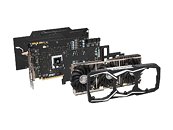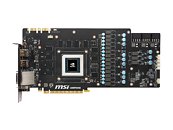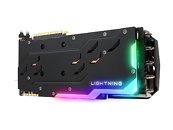Thursday, July 13th 2017

MSI GTX 1080 Ti Lightning X and Z Now Available on Newegg- $859/869
MSI's flagship Lightning series made a comeback to the green side with the NVIDIA GTX 1080 Ti GPU, and they are now available for purchase on Newegg.com in the USA. In a relatively pleasant surprise, they are also selling for a lot lower than what we were originally told by MSI, and at $869.99 for the top-of-the-line Lightning Z, it comes in at $170 more than what the NVIDIA reference (no more Founders Edition price hike, if you may recall) is listed for.
We took a detailed look at the MSI GTX 1080 Ti Lightning Z earlier this week and were quite impressed with the overall build quality and cooler: "MSI's GTX 1080 Ti Lightning is huge, having three slots, taking up 32 cm in length and 14 cm in height - make sure your case has room for it. As expected, a powerful thermal solution is included, which seems to be the best cooler I've seen in a long time. Temperatures are outstanding and better than any other GTX 1080 Ti, even with the overclock out of the box, which is higher than any other GTX 1080 Ti. At the same time, fan noise also matches the quietest GTX 1080 Tis (33 dBA), which clearly adds up to 'best cooler'."The two models are near identical with the Lightning X variant rated at a base clock / boost clock / memory frequency of 1480 MHz / 1582 MHz / 11016 MHz (Silent Mode), 1544 MHz / 1657 MHz / 11124 MHz (Gaming Mode), and 1569 MHz / 1683 MHz / 11124 MHz (Lightning Mode) respectively whereas the Lightning Z variant is rated at 1480 MHz / 1582 MHz / 11016 MHz (Silent Mode), 1582 MHz / 1695 MHz / 11124 MHz (Gaming Mode), and 1607 MHz / 1721 MHz / 11124 MHz (Lightning Mode). NVIDIA GPU Boost 3.0 will likely boost the core frequencies even further ahead, and as with any Pascal-architecture GeForce GPU, a hard temperature and voltage wall ends up being an equalizer with most topping out around the 2050-2100 MHz mark. So you are really paying for the much better cooler, the overbuilt PCB, the limited nature of the card with only 3000 pieces worldwide, and of course the RGB lighting.
Sources:
MSI GTX 1080 Ti Lighting X on Newegg, MSI GTX 1080 Ti Lighting Z on Newegg
We took a detailed look at the MSI GTX 1080 Ti Lightning Z earlier this week and were quite impressed with the overall build quality and cooler: "MSI's GTX 1080 Ti Lightning is huge, having three slots, taking up 32 cm in length and 14 cm in height - make sure your case has room for it. As expected, a powerful thermal solution is included, which seems to be the best cooler I've seen in a long time. Temperatures are outstanding and better than any other GTX 1080 Ti, even with the overclock out of the box, which is higher than any other GTX 1080 Ti. At the same time, fan noise also matches the quietest GTX 1080 Tis (33 dBA), which clearly adds up to 'best cooler'."The two models are near identical with the Lightning X variant rated at a base clock / boost clock / memory frequency of 1480 MHz / 1582 MHz / 11016 MHz (Silent Mode), 1544 MHz / 1657 MHz / 11124 MHz (Gaming Mode), and 1569 MHz / 1683 MHz / 11124 MHz (Lightning Mode) respectively whereas the Lightning Z variant is rated at 1480 MHz / 1582 MHz / 11016 MHz (Silent Mode), 1582 MHz / 1695 MHz / 11124 MHz (Gaming Mode), and 1607 MHz / 1721 MHz / 11124 MHz (Lightning Mode). NVIDIA GPU Boost 3.0 will likely boost the core frequencies even further ahead, and as with any Pascal-architecture GeForce GPU, a hard temperature and voltage wall ends up being an equalizer with most topping out around the 2050-2100 MHz mark. So you are really paying for the much better cooler, the overbuilt PCB, the limited nature of the card with only 3000 pieces worldwide, and of course the RGB lighting.




15 Comments on MSI GTX 1080 Ti Lightning X and Z Now Available on Newegg- $859/869
For pricing reasons, I probably would just pick the cheapest option I was happy with in terms of looks. Would not be willing to spend the extra on this card.
Personally, I don't judge these cards based on the same criteria I use when I buy my mid-range $200-300 video card, the same as I don't judge a custom tuned car by same criteria I use when I buy an everyday use sedan. These are targeted at a very limited audience and are there mostly to display engineering prowess. Proving effective, cost-effective or reasonable is pretty much besides the point. And yes, when engineering fails, some designs end up not making much sense.
Joking aside, we all know not to judge a product by its launch price, don't we?
The clocks will top out at the exact same level, give or take 50mhz due to silicon lottery. Fastest or not has nothing to do with it being a Lightning or not, nor with the overbuilt cooling solution.
Bottom line is you pay 70 bucks for a fancy LED, and that is already on top of the premium-epeen-tax these cards have.